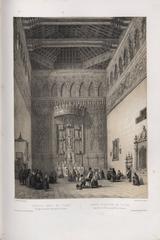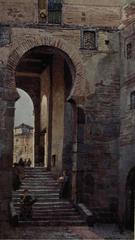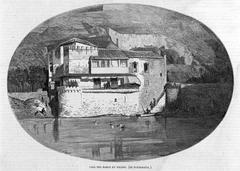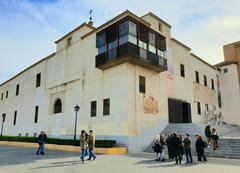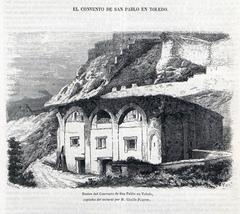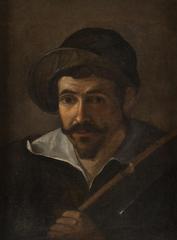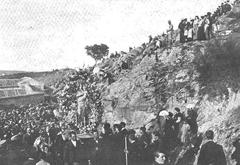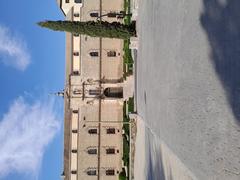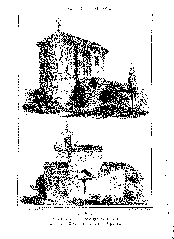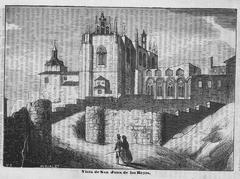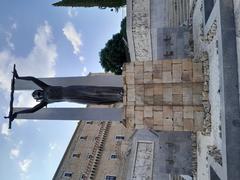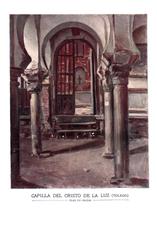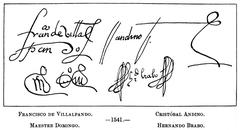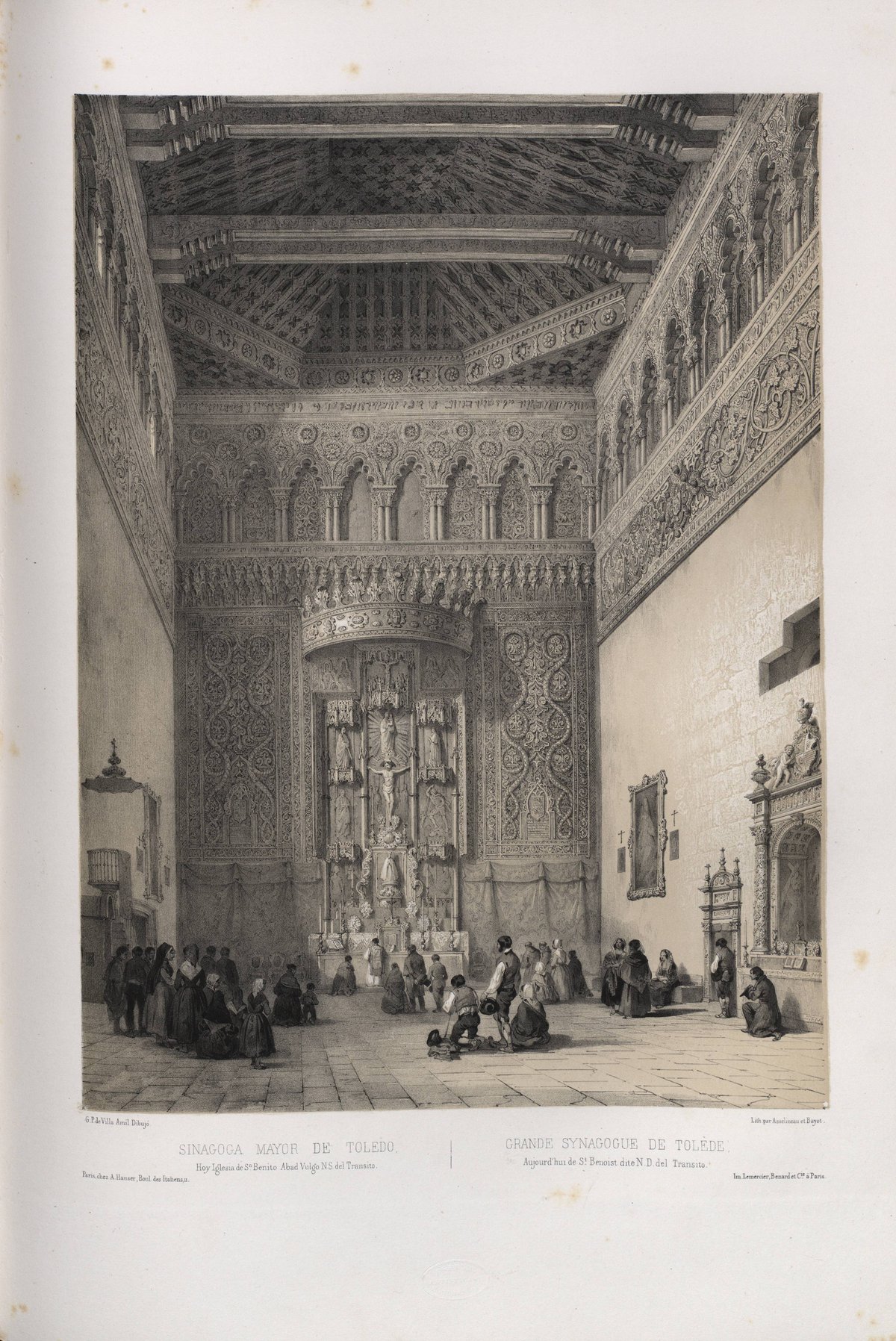
Visiting Sinagoga del Tránsito in Toledo: History, Tickets, and Tips
Date: 18/07/2024
Introduction
Discover the rich history and architectural splendor of the Sinagoga del Tránsito in Toledo, Spain. This historic synagogue, built in the 14th century, stands as a testament to the cultural and religious diversity that once thrived in medieval Spain. Constructed in 1357 by Samuel ha-Levi Abulafia, the synagogue is an exemplary model of Mudéjar architecture, a style that harmoniously blends Islamic, Christian, and Jewish artistic elements. Its intricate stucco work, geometric patterns, and elaborate wooden ceiling reflect the multicultural influences of a time known as the Convivencia, when Christians, Muslims, and Jews coexisted peacefully (Museo Sefardí, Toledo Tourism). Today, the Sinagoga del Tránsito houses the Sephardic Museum, preserving and showcasing the history and culture of the Sephardic Jews. This guide provides comprehensive details on the synagogue’s storied past, visitor information, and practical tips to enhance your visit.
Table of Contents
- Introduction
- History of Sinagoga del Tránsito
- Visitor Information
- Notable Features
- FAQ
- Conclusion
- References and Further Reading
History of Sinagoga del Tránsito
Origins and Construction
The Sinagoga del Tránsito, also known as the Synagogue of Samuel ha-Levi, is a historic synagogue located in Toledo, Spain. It was constructed in 1357 by Samuel ha-Levi Abulafia, the treasurer to King Pedro I of Castile. The synagogue was built during a period of relative tolerance and prosperity for the Jewish community in Spain, which allowed for the creation of such an elaborate and significant structure. The construction of the synagogue was completed in a remarkably short period, reflecting the wealth and influence of its patron.
Architectural Significance
The Sinagoga del Tránsito is renowned for its stunning Mudéjar architecture, a style that combines Islamic, Christian, and Jewish artistic elements. The synagogue’s interior is adorned with intricate stucco work, featuring geometric patterns, Arabic inscriptions, and Hebrew texts. The wooden ceiling is a masterpiece of craftsmanship, showcasing elaborate designs that reflect the multicultural influences of the time. The use of these diverse artistic elements highlights the cultural and religious syncretism that characterized medieval Spain.
Historical Context
The construction of the Sinagoga del Tránsito occurred during a period of relative peace and coexistence known as the Convivencia, where Christians, Muslims, and Jews lived together in relative harmony. However, this period was not without its challenges. The 14th century was marked by political instability, social unrest, and economic difficulties, which eventually led to increased tensions between different religious communities.
The Expulsion of the Jews
The history of the Sinagoga del Tránsito took a dramatic turn in 1492, when the Catholic Monarchs, Ferdinand and Isabella, issued the Alhambra Decree, ordering the expulsion of all Jews from Spain. This decree marked the end of the Jewish community’s presence in Toledo and the beginning of a new chapter for the synagogue. Following the expulsion, the synagogue was converted into a church, known as the Church of San Benito, and later served various other purposes, including a military barracks and a hospital.
Preservation and Restoration
The Sinagoga del Tránsito underwent significant changes and suffered from neglect over the centuries. It wasn’t until the 19th century that efforts were made to preserve and restore the building. In 1877, the Spanish government declared the synagogue a national monument, recognizing its historical and cultural significance. Restoration efforts were undertaken to preserve the intricate stucco work and other architectural features, ensuring that future generations could appreciate this remarkable example of medieval Jewish architecture.
The Sephardic Museum
In 1964, the Sinagoga del Tránsito was transformed into the Sephardic Museum, dedicated to preserving and showcasing the history and culture of the Sephardic Jews. The museum houses a vast collection of artifacts, including religious objects, manuscripts, and historical documents, providing visitors with a comprehensive understanding of the rich heritage of the Jewish community in Spain. The museum also serves as a center for research and education, promoting the study of Sephardic history and culture.
Visitor Information
Visiting Hours and Tickets
- Visiting Hours: The Sinagoga del Tránsito is typically open to visitors from Tuesday to Sunday, 9:30 AM to 2:00 PM and 4:00 PM to 6:30 PM. It is closed on Mondays and certain public holidays. It’s advisable to check the official website for any changes in the schedule before planning your visit.
- Tickets: Admission fees are generally affordable, with discounts available for students, seniors, and groups. Tickets can be purchased online or at the entrance.
Travel Tips
- Getting There: The synagogue is located in the Jewish Quarter of Toledo, a short walk from other major attractions. Public transportation options include buses and taxis.
- Nearby Attractions: While visiting the Sinagoga del Tránsito, consider exploring nearby sites such as the El Greco Museum, the Toledo Cathedral, and the Monastery of San Juan de los Reyes.
- Accessibility: The museum strives to be accessible to all visitors, though some areas may present challenges for those with mobility issues. Contact the museum in advance for specific accessibility information.
Special Events and Guided Tours
The Sinagoga del Tránsito occasionally hosts special events, including lectures, cultural performances, and temporary exhibitions. Guided tours are available and highly recommended for a deeper understanding of the site’s history and significance. Check the museum’s website for details on upcoming events and tour schedules.
Photography
Visitors are generally allowed to take photographs for personal use, but flash photography and the use of tripods are usually prohibited. Capture the stunning stucco work and wooden ceiling, but remember to respect museum guidelines and other visitors.
Notable Features
Stucco Decoration
The synagogue’s walls are adorned with intricate stucco decorations, featuring a combination of Arabic and Hebrew inscriptions. These decorations are a testament to the skilled craftsmanship of the artisans who created them and reflect the multicultural influences of the time.
Wooden Ceiling
The wooden ceiling of the Sinagoga del Tránsito is a masterpiece of Mudéjar art, showcasing elaborate geometric patterns and intricate designs. The ceiling is one of the most well-preserved features of the synagogue and is a highlight for visitors.
Hebrew Inscriptions
The synagogue features numerous Hebrew inscriptions, including biblical verses and dedications. These inscriptions provide valuable insights into the religious and cultural life of the Jewish community in medieval Toledo.
FAQ
- What are the visiting hours for Sinagoga del Tránsito?
- The synagogue is open from Tuesday to Sunday, 9:30 AM to 2:00 PM and 4:00 PM to 6:30 PM. It is closed on Mondays and certain public holidays.
- How much are tickets for Sinagoga del Tránsito?
- Ticket prices are affordable, with discounts for students, seniors, and groups. Check the official website for current pricing.
- Is the Sinagoga del Tránsito accessible?
- The museum aims to be accessible, though some areas may be challenging for visitors with mobility issues. Contact the museum for specific information.
Conclusion
The Sinagoga del Tránsito in Toledo is more than just a historical site; it is a symbol of the rich, diverse cultural tapestry of medieval Spain. Whether you’re exploring its intricate stucco work, delving into the history of the Sephardic Jews, or simply enjoying the serene atmosphere, a visit to this remarkable synagogue is an unforgettable experience. Plan your trip, explore the history, and immerse yourself in the legacy of one of Toledo’s most significant landmarks.
